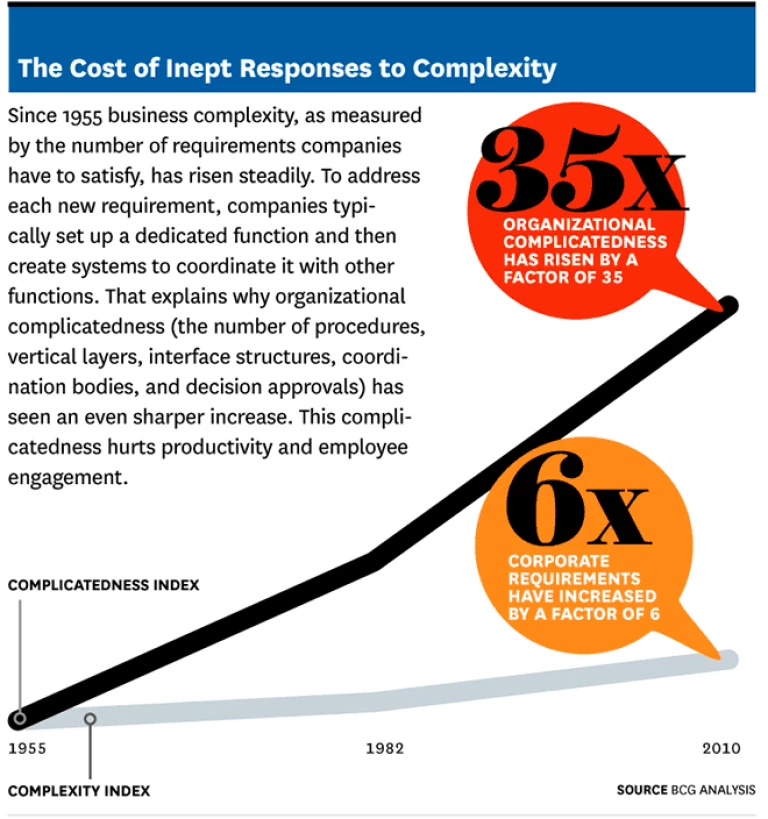Companies face an increasingly complex world. Globalization and technology have opened up new markets and enabled new competitors. With an abundance of options to choose from, customers are harder to please—and more fickle—than ever. Each day competitive advantage seems more elusive and fleeting. Even if you can figure out the right approach to take, what works today won’t work tomorrow.
The growth of complexity is reflected in businesses’ goals. Today companies, on average, set themselves six times as many performance requirements as they did in 1955, the year the Fortune 500 list was created. Back then, CEOs committed to four to seven performance imperatives; today they commit to 25 to 40. And many of those requirements appear to be in conflict: Companies want to satisfy their customers, who demand low prices and high quality. They seek to customize their offerings for specific markets and standardize them for the greatest operating return. They want to innovate and be efficient.
In and of itself, this complexity is not a bad thing—it brings opportunities as well as challenges. The problem is the way companies attempt to respond to it. To reconcile their many conflicting goals, managers redesign the organization’s structure, performance measures, and incentives, trying to align employees’ behavior with shifting external challenges. More layers get added, more procedures imposed. Then, to smooth the implementation of those “hard” changes, companies introduce a variety of “soft” initiatives designed to infuse work with positive emotions and create a workplace where interpersonal relationships and collaboration will flourish.
At The Boston Consulting Group, we’ve created an “index of complicatedness,” based on surveys of more than 100 U.S. and European listed companies, which measures just how big the problem is. The survey results show that over the past 15 years, the amount of procedures, vertical layers, interface structures, coordination bodies, and decision approvals needed in each of those firms has increased by anywhere from 50% to 350%. According to our analysis over a longer time horizon, complicatedness increased by 6.7% a year, on average, over the past five decades.
This complicatedness exacts a heavy price. In the 20% of organizations that are the most complicated, managers spend 40% of their time writing reports and 30% to 60% of it in coordination meetings. That doesn’t leave much time for them to work with their teams. As a result, employees are often misdirected and expend a lot of effort in vain. It’s hardly surprising that employees of these organizations are three times as likely to be disengaged as employees of the rest of the group—or that dissatisfaction at work is so high and productivity so often disappointing.
Companies clearly need a better way to manage complexity. In our work with clients and in our research, we believe, we’ve found a different and far more effective approach. It does not involve attempting to impose formal guidelines and processes on frontline employees; rather, it entails creating an environment in which employees can work with one another to develop creative solutions to complex challenges. This approach leads to organizations that ably address numerous fluid and contradictory requirements without structural and procedural complicatedness.
The approach incorporates a set of simple yet powerful principles. We call them “smart rules.” These rules help managers mobilize their subordinates’ skills and intelligence.
There are six smart rules. The first three involve enabling—providing the information needed to understand where the problems are and empowering the right people to make good choices. The second three involve impelling—motivating people to apply all their abilities and to cooperate, thanks to feedback loops that expose them as directly as possible to the consequences of their actions. The idea is to make finding solutions to complex performance requirements far more attractive than disengagement, ducking cooperation, or finger-pointing. When the right feedback loops are in place, cumbersome alignment mechanisms—ranging from compliance metrics to the proliferation of committees—can be eliminated, along with their costs, and employees find solutions that create more value.
As you will see in the following pages, using the smart rules—all of them, or sometimes just one or two—enables a complicated company to transform itself, in part or sometimes completely, into a smarter, more streamlined organization.
Rule 1: Improve Understanding of What Coworkers Do
To respond to complexity intelligently, people have to really understand each other’s work: the goals and challenges others have to meet, the resources they can draw on, and the constraints under which they operate. People can’t find this kind of information in formal job descriptions; they can learn it only by observing and interacting.
The manager’s job is to make sure that such learning takes place. Without this shared understanding, people will blame problems on other people’s lack of intelligence or skills, not on the resources and constraints of the organization.
This was the case at the hotel unit of a global travel and tourism group that was struggling with falling occupancy rates, declining prices, and poor customer satisfaction. Many of the hotel managers blamed the “detached mentality” and weak customer-facing skills of the reception employees, who were young and inexperienced—and never stayed long enough to learn better. The sales managers at the group center agreed, even accusing receptionists of contributing to low occupancy rates by pretending that no rooms were available when in fact the hotels had vacancies. The chain therefore decided to set up an incentive based on occupancy rates and sales for the receptionists and to train them in customer service.
Despite all the energy devoted to these initiatives, the results did not improve. Eventually, a team of salespeople decided to spend one month with the receptionists to see what was really going on. The team discovered that the receptionists’ most pressing challenge was handling unhappy customers. Their constraint was a lack of cooperation from the support functions, including housekeeping, room service, and maintenance, whose actions had the most effect on customer satisfaction. Housekeeping, for instance, regularly failed to inform maintenance about broken appliances in rooms, leaving the people at reception to manage the customers’ complaints at night.
To compensate for this lack of cooperation, receptionists were drawing on other resources. One was the refunds they could grant to defuse angry complaints at checkout. The new training actually made receptionists much more at ease with entering rebate discussions, which inevitably pushed price points down further.
A second resource was their own youthful energy: When a guest complained, the receptionists would try to fix the problem themselves, abandoning the front desk to make a faulty shower work or to dash around looking for a spare remote control to replace a broken one. By the time they got back to the front desk, a line of fuming guests would have formed.
Their third resource was offering unhappy guests an upgrade, which meant they needed to keep some rooms in reserve—a practice that depressed occupancy rates. The new incentives were useless, because they had no impact on the lack of cooperation from the support functions and how the receptionists coped with it. The bonus scheme, which showed receptionists how much they could have earned each day, only increased their frustration.
Exhausted and discouraged, the young clerks would often quit after a few weeks. Their high turnover rate didn’t stem from a lack of commitment, as the sales team had believed. On the contrary, the receptionists who cared the least were the ones who stayed the longest.
Exploring the real context of employees’ work helps managers discover when people need to cooperate and how well they’re doing it. Although you can measure the combined output of a group, it is difficult to measure the input of each member, and the more cooperation there is, the harder it gets. Indeed, when managers rely on traditional metrics and peer feedback, they may end up rewarding people who actually avoid cooperation.
Of course, it isn’t always feasible for a manager to spend a month observing in minute detail what’s happening on the front line. But managers do need to supplement the formal metrics and reports they receive with observation and with judgment when measurement is impossible. In many cases, just a day on the ground watching the interplay among people from different functions will provide insights into where and how cooperation is breaking down. Once you identify that moment of truth and some simple root causes, you can move on to applying the other rules.
Rule 2: Reinforce the People Who Are Integrators
Conflicts between front and back offices are often inherent. Back offices typically need to standardize processes and work, and front offices have to accommodate the needs of individual customers.
A common organizational response is to create some sort of coordinating unit—a middle office. But that just turns one problem into two: between the back and middle offices, and between the middle and front offices. The same thing happens vertically in organizations: Coordination problems between the corporate center and country operations trigger the creation of regional layers in between. Another common solution is to impose a coordinating procedure like computerized job requests.
A better response is to empower line individuals—or groups—to play that integrative role. In almost any unit you will find one or two managers—often from a particular function—who already interact with multiple stakeholders (customers as well as other functions). If you’ve followed the first rule and observed people at work, it will probably be fairly obvious to you who these individuals or groups are. These people can act as integrators, helping teams obtain from others the cooperation needed to deliver more value.
Once you’ve identified them, you should reinforce their power by increasing their responsibilities and giving them a greater say on issues that matter to others. Removing some formal rules and procedures also helps increase the discretionary power of integrators. The larger a company gets, the greater the need for integrators, and therefore the fewer formal rules there should be. Unfortunately, most managers think the exact opposite is true.
At the struggling hotel group, the managers realized that the receptionists could play a key integrative role among the hotel staff and the customers. But rather than coordinating those interactions through a formal process, the company decided to give the reception staff a stronger voice in the promotions of people in support functions—particularly the housekeepers and the maintenance crew.
The housekeepers soon started to cooperate by checking all equipment and appliances as they were cleaning rooms; maintenance would then readily intervene during the day, so that customers would not discover problems at night. The change had a snowballing effect on customer satisfaction—eliminating the need to grant rebates at checkout—and on the receptionists’ willingness to sell available rooms. Within 18 months, the company’s gross margin had increased by 20%.
Rule 3: Expand the Amount of Power Available
Usually, the people with the least power in an organization shoulder most of the burden of cooperation and get the least credit. When they realize this, they often withdraw from cooperation and hide in their silos. Companies that want to prevent this and increase cooperation need to give these people more power so that they can take the risk of moving out of isolation, trusting others, showing initiative, and being transparent about performance.
However, firms have to do this without taking power away from others in the system. The answer is to create new power bases, by giving individuals new responsibilities for issues that matter to others and to the firm’s performance.
The experiences of a large retailer illustrate how this works. The retailer had decided to lower costs and enhance professionalization by centralizing the procurement and human resources functions that used to reside in individual stores. Store managers lost a lot of power in the process; it was clear that the issues that mattered to store employees were now in the hands of centralized shared services. The store managers had become a kind of “nice but useless nanny,” as someone actually put it.
Yet the store managers were supposed to play a strong role in making sure employees were responsive to customer needs and were a primary source of innovations for store layouts and shop floor operations. Without organizational clout, how were they to do this?
The chain’s senior managers addressed the problem by announcing to customers that the lines in front of cashiers would not exceed a certain length in their stores. This mattered for performance because lines had a large impact on customers’ loyalty and frequency of visits. The store managers were given responsibility for assembling the teams—from any section in the stores—that would come and help the cashiers if the lines were about to exceed the limit. That mattered to the floor staff: Having to feel the heat of unhappy customers—who were all the more vocal once the company had publicly committed to short lines—was not a trivial issue. The ability to decide who would be picked for these teams gave the store managers the power to foster cooperation and diligence in store operations and innovations.
New sources of power can also be created around expertise building and knowledge transmission. This works especially well if both project managers and line managers need more power. Project managers can assess and reward project-related performance, and line managers can decide who gets to be trained in the higher-order management skills that will improve chances for promotion.
Rule 4: Increase the Need for Reciprocity
A good way to spur productive cooperation is to expand the responsibilities of integrators beyond activities over which they have direct control. Making their goals richer and more complex will drive them to resolve trade-offs rather than avoid them. But if you measure people only on what they can control, they will shy away from helping with many other problems you need their input on.
Consider the case of an airline that competes on asset utilization (having planes full and in the air rather than waiting on the ground) but doesn’t want to compromise customer satisfaction. To achieve high utilization and satisfaction, the company makes aircraft crew members accountable for overseeing both cabin cleaning and ground service. They cannot blame someone else—like the cleaning subcontractor—when customers grumble about a messy plane or a slow boarding crew. The superior trade-off they are impelled to achieve—reconciling cabin cleanliness, customer experience, and speed of turnaround between flights (which is about twice that of other airlines)—would be out of reach if people were not allowed to decide what works best in each situation and instead followed predefined procedures and were measured by their compliance with them.
As you spread responsibility for achieving outcomes, don’t feel you have to give people more resources to go with it. It’s actually often better to take resources away. A family with five television sets doesn’t have to negotiate which program to watch because everyone can watch the show he or she wants. The result is the kind of self-sufficiency that kills family life. Removing resources is a good way to make people more dependent on, and more cooperative with, one another, because without such buffers, their actions have a greater impact on one another’s effectiveness. Eliminating internal monopolies—by creating overlaps, bundling activities, or even setting up external alliances—also increases the possibility for reciprocal action and impels cooperation.
It might seem that you will multiply the number of goals and targets by applying this rule. Actually, this is not the case. What you will do is drive goals back to the employees who actually have to achieve them, so that the people who are best positioned to resolve trade-offs are the ones handling them. Indeed, the multiplication of corporate requirements that we described earlier is arguably a transfer up the hierarchy of certain goals and accountabilities that should remain nearer the bottom of the organization.
Rule 5: Make Employees Feel the Shadow of the Future
The longer it takes for the consequences of a decision to take effect, the more difficult it is to hold a decision maker accountable. Many who are involved at the launch of a three-year project will no longer be around when it’s completed—they will have been moved to another job or location, or promoted. They won’t be affected by the consequences of the actions they take, the trade-offs they make, or how well they cooperate. To paraphrase game-theorist Robert Axelrod, the “shadow” of the future does not reach them.
People are more likely to feel the shadow of the future if you bring the future closer. For example, the lead times on many projects or work processes can often be significantly reduced at companies.
Another remedy is just to assign managers to downstream work. Consider the case of an industrial goods company that needed to lengthen the warranty period on certain products in order to fend off new competition. To do this cost-effectively, its engineering division had to make the product easier to repair.
The engineers were already laboring to meet many requirements—including product compactness, energy consumption, and anticorrosion performance—each of which came with a set of goals, incentives, and people who oversaw it. Now management added a repairability requirement to the list. It established a new function that would coordinate all the decisions that affected repairability with all the engineering specialties—notably the mechanical and electrical groups. It also defined a repairability process and a set of performance indicators and incentives to go with it.
None of the changes helped. Given the number of other incentives, the repairability incentive was insignificant (it could make at most a 0.8% difference in the engineers’ compensation), whereas the overall requirements had become more complex. For example, if the engineers met the requirement for compactness, the product became much more difficult and costly to repair, owing to the intricacy of mechanical and electrical parts. The conflict between compactness and repairability was not new. What was new was the competitive pressure that removed the possibility of fulfilling one requirement and sacrificing the other. Moreover, the coordinators could not get the electrical and mechanical engineers to cooperate on repairability. Numerous “soft” initiatives to improve interpersonal feelings within these groups had made them even more reluctant to strain their relationships by negotiating tough tradeoffs between electrical and mechanical constraints. Real cooperation, after all, is not a matter of getting along well; it’s taking into account the constraints and goals of others in your actions and decisions. Indeed, people get along all the better if they can avoid such real cooperation.
The after-sales team continued to struggle with costly repair operations, and the warranty period could not be extended. Then the company tried a new approach: moving some of the engineers to the after-sales network once the new products were launched and making them responsible for the warranty budget. This meant that they would experience firsthand the effects of their design on that budget. The touchy-feely approach to collaboration, with its convivial avoidance of real cooperation, stopped, and engineers quickly started to address the tough trade-offs. The innovative solutions they developed enabled the company to meet both its repairability goals and the other requirements. Soon it extended the warranty period and did away with the coordination function and its processes, scorecards, and incentives.
Increasing the frequency of output performance reviews also makes employees feel the shadow of the future more. A telecom systems manufacturer that was struggling to integrate its hardware and software engineering units discovered this when it upped the frequency with which it tested the compatibility of hardware and software from every six months to every two weeks. Previously, engineers from either unit could avoid cooperating and not face any consequences for at least five months and 29 days. Now the consequences can be avoided for only 13 days.
Rule 6: Put the Blame on the Uncooperative
Some activities involve such a long time lag between cause and effect (for example, in some research and development efforts) that it’s impossible to set up direct feedback loops that expose people to the consequences of their actions. There are also situations where jobs are so remote that it’s difficult to have a direct feedback loop that makes the people who perform them feel interdependent with others. In those cases, managers have to close the feedback loop themselves by explicitly introducing a penalty for any people or units that fail to cooperate on solving a problem, even if the problem does not occur in their area, and increase the payoff for all when units cooperate in a beneficial way.
This was the approach taken by one railway company that was struggling to boost its on-time record, which for years had not risen above 80%. It had tried to improve punctuality by upgrading traffic control mechanisms, hiring more agents, dedicating more resources to the function in charge of monitoring delays, and skimping on some operations (such as cleaning and equipment checks). But each measure that slightly increased punctuality also had an unacceptably negative impact on other performance requirements, such as cost, quality, and safety.
So the company took a new tack. Applying Rule 1, it focused on cooperation between the units whose performance affected timeliness (which included maintenance, train drivers, station crews, and conductors). It became clear that each unit could, by cooperating, anticipate, absorb, and compensate for the delays or problems occurring in other units. But the company also realized that the people working in the various units were more concerned with not getting blamed for delays than with reducing them.
That situation was the result of perverse rules that prevented people from improving timeliness. Under them, blame for a delay was placed only on the unit responsible for its root cause. So, when Unit A had a problem, Units B and C did not feel impelled to help solve it. Why would they? If they didn’t cooperate, only Unit A got the blame. Instead, each unit tried to make up the lost time by itself. In 20% of cases, however, that wasn’t enough.
The company needed to modify the reward criteria so that it would be in the interest of those who needed help to be transparent about it, and of others to provide that help. It was decided that once a unit told others it had a problem, the units that failed to cooperate in solving the problem would be held responsible for the delay. The station managers, who would be present in the necessary moments of cooperation, would judge which units had contributed to solving problems. In just four months on-time performance jumped up to 95% on the major lines where the change was implemented.
What Not to Do
You may find it helpful to keep in mind the following caveats—what I think of as “the don’ts.” If you catch yourself ignoring any of them, you’re probably not applying the smart rules.
Never add a process or a layer unless you absolutely have to.
Adding or keeping what is unnecessary is at least as damaging as lacking what is needed.
Never blame a problem on someone’s mentality or mind-set.
This reflects only the limitations of your analysis. Instead look at the goals, resources, and constraints people face.
Don’t let decisions be escalated to you.
Push them back to those who failed to cooperate on a solution. But if you must take on a decision, hold the local people accountable and make it a learning experience: “What will you guys do differently the next time so I don’t have to arbitrate?”
Don’t rely on financial incentives.
The counterproductive side effects are too severe. Instead try to embed feedback loops into people’s tasks.
Don’t try to measure specific behaviors.
The most valuable behavior—cooperation—cannot be measured. And in the few performance areas that do not require cooperation, the effects of people’s behaviors show up directly in the business results. Focus instead on results, and use judgment rather than measurements when cooperation is required.
Smart rules allow companies to manage complexity not by prescribing specific behaviors but by creating a context within which optimal behaviors occur—even though what is optimal cannot be defined in advance. This approach leads to greater organizational diversity, because voluntary frontline cooperation breeds creative, customized solutions to problems. Yet despite this diversity, companies following smart rules are highly efficient in terms of the resources they use, because problems are solved entirely by leveraging, through cooperation, the skills and ingenuity of employees. Any costs generated by the diversity are more than off set by being able to ditch all the coordination and collaboration programs favored by many organizational experts. Employee satisfaction rises along with performance, as companies remove the complicatedness that causes both frustration and ineffectiveness. So rather than overload your org chart with a lot of arrows and layers, why not aim for the kind of smart simplicity you’ll get from applying the six rules described in this article?
This article
originally appeared in the
Harvard Business Review
and is republished here with permission.







